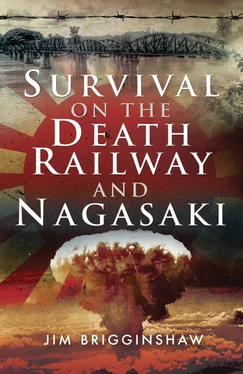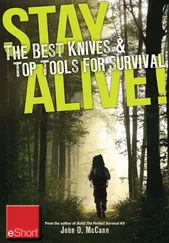The new camp had bamboo huts with attap roofs that were as useless as the gunyahs for keeping out the rain, which poured every day.
One advantage of the huts, however, was that instead of sleeping in water, they now had raised bamboo platforms. After a particularly heavy downpour one night, the men awoke next morning to see the rotting legs and arms of corpses sticking up stiffly out of the dirt floor under their sleeping platforms. These were the remains of natives who had lived in the huts previously and had been buried under them. The deluge during the night had caused the saturated earth to subside, uncovering their bodies.
Scabies, brought on by malnutrition and lack of vitamins, was rife. A skin infection, scabies produces constant itching and victims scratch until the infected areas-mostly around the midriff, the armpits and the crotch-become open sores.
The only treatment available at the camp was lime and sulphur. This was added to large wooden tubs of hot water that stood outside a hut that acted as a hospital. Scabies victims would squat in the tubs, immersed to the neck in the smelly liquid. It was the only way to combat the itching.
Opposite the tubs and separated from them by a barbed wire fence was a hut containing Japanese stores. One day, a prisoner who had been working for the Korean guards came back with the news that a bag of salt had been left outside the store hut.
Salt was badly needed. A substitute for sugar had been found in chindegar, the sap of the goola malacco tree, which when coagulated became a caramel the natives fed to their elephants, but there was no substitute for salt. A bagful of it lying untended outside a Japanese store hut was too tempting to overlook.
Two prisoners sneaked through the barbed wire after dark, grabbed the bag of salt and took it to the hospital hut, believing it would remain undetected there because the Japanese gave the hut a wide berth, knowing that it housed men with a variety of lethal diseases.
However, the Japanese regarded the Korean guards as expendable, so they were sent to search the hut. They didn’t have to be Sherlock Holmes to know where the salt was located. It had leaked through a tear in the bag, and a white trail led directly to the hospital hut. The Koreans, with fixed bayonets, followed the trail like bloodhounds on the scent.
The prisoners saw them coming. Outside the hut, a scabies victim was up to his neck in the sulphur and lime tub. The prisoners pulled the naked man out, tossed the bag of salt into the tub , then had him get back in and sit on it. He suffered in stoic silence as the water gradually dissolved the salt, which entered his raw sores. After the guards left, the scabies victim climbed out of the tub, his skin as red as a bad case of sunburn.
Some of the salt hadn’t dissolved in the tub, and because it was too precious to waste, what was left was retrieved and used by those who didn’t mind the flavour of sulphur and lime.
Sickness, starvation and exhaustion continued to extract a heavy toll on the camp workforce. The Australian camp doctors told the Japanese railway engineers that with so many men affected, soon there’d be nobody left to do the work.
The Japanese, who knew they couldn’t have a shortage of labour on their railway if it was to be finished on schedule, allowed the doctors to classify a given number of sick prisoners each day as ‘no-duty men’. They were issued with a ‘no duty’ metal disc that was hung around their neck on a cord and entitled them to a day of rest.
At the end of each day’s work the doctors held a sick parade and selected the no-duty quota for next day.
A British prisoner who was not sick, but exhausted from slaving on the railway line, tried to get a no-duty disc. He squinted, screwed up his eyes, rubbed at them and told the examining doctor, ‘My eyesight is failing, sir. I can hardly see.’
Eye complaints weren’t uncommon. Lack of vitamins was affecting the sight of many prisoners. To test how bad this case was, the doctor pointed to three shovels on a table some distance away. ‘What’s on that table, soldier?’
The Pom squinted and rubbed his eyes. ‘Three no-duty discs, sir.’
The doctor smiled and gave him a disc.
As the railway line progressed, the prisoners had to march further to their place of work. They were guarded on the way by Koreans, who would hand them over to the Japanese engineers at the worksite.
Meals had to be brought from the camp, often over long distances, and prisoners were used for this. No guards went with them, as there was nowhere to escape to in this wilderness. The food the prisoners carried back, buckets of well-cooked rice and thick vegetable and meat stew, was for the guards. The prisoners would get a small portion of rice.
The starving men who carried back the buckets of food would be taunted by the smell and the knowledge that they’d get none of it, which was often too much to bear. Even though they’d been warned that eating any of the food would result in execution, they’d help themselves on the way back to the railway workers. To cover the reduced level in the buckets, they squatted over them. It was disgusting, but they regarded it as necessary to keep them alive and also as a way of killing Japanese. It was their form of germ warfare. Dysentery had been given to them by their captors, so it seemed fair enough to give it back to them.
Food supplies for the prisoners at the railway camps, which were always at a minimum, were being further depleted by natives and Japanese stealing them on the way up the line. The food situation deteriorated further when Dutch prisoners of war, civilians brought from Java and Sumatra to work on the railway line, used money that they had brought with them to buy rations that were meant to be used for the other prisoners.
CHAPTER SIX
FRIENDLY FIRE
DYSENTERY almost killed Bodero at the Twenty-six-Kilo camp. He was losing large quantities of blood, but was still required to work on the line every day. In the early part of May 1943, he collapsed and was taken back to the hospital at Thambuzyat.
The hospital, a couple of wooden buildings set apart from the others, had been rendered safe from bombing and strafing by Allied planes after the prisoners had dug a huge cross in the ground that could be seen from the air. However, their confidence that they’d safeguarded the hospital patients was soon to be tested.
The prisoners were allowed to spend any money they had at the hospital canteen run by an English warrant officer. Australian officers were required to pay the Japanese for board and lodging. Any money they had left was used to buy eggs and bananas for the dying.
The English warrant officer in charge of the canteen was allowed to stay in there alone at night, time he put to good use by operating a hidden wireless. He was helped each night by a prisoner who sneaked into the canteen. They knew that if they were found operating the wireless, they wouldn’t have much of a future, so they invented an excuse for why they were often together; they’d pretend to be homosexual lovers. Neither was that way inclined, so they were pleased that they were never required to put their plan into operation. Meanwhile, their radio continued to provide occasional news of how the war was going.
The skies above Thambazyat were normally free of aircraft, so it was a surprise when a plane appeared at a great height one night. It approached from the west and disappeared to the east, but it was too high to be able to tell whether it was an Allied or a Japanese plane.
A quarter of an hour later, at about one o’clock in the morning, it was back. Still at a high altitude, it began circling the camp. Then it dropped two flares that lit up the hospital.
‘ He’s going to bomb us,’ somebody in the hospital yelled. ‘I’m out of here.’
Читать дальше












